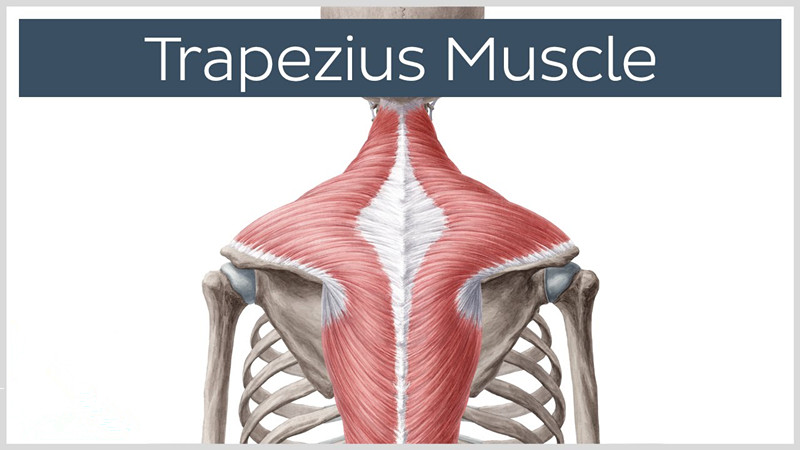The trapezius is a large triangular shaped muscle that is located at the base of the back of the neck, running along the shoulder blades, one on each side. It is a heavily used muscle in the body, and numerous causes can lead it to strain or spasms. Some of these causes may require medical intervention to heal properly and quickly, meaning it is a good idea to know the potential causes and treatment methods for a trapezius muscle spasm.

Symptoms of Trapezius Muscle Spasm
When a muscle begins to spasm, every fiber within it is essentially contracting simultaneously, tightening and causing a cut off in blood flow to the area. Spasms are often accompanied with muscle tingling, pain, stiffness, and weakness. Unlike muscle cramping, spasms will not be eased with stretching or movements. In fact, it can be almost impossible to move the muscle effectively whilst it spasms.
Causes of Trapezius Muscle Spasm
Muscle spasms of the trapezius are most commonly caused by the muscle being strained, stretched, torn, or otherwise injured. This may be done whilst exercising (especially if you didn’t properly stretch), lifting heavy objects (especially if you do not practice proper technique, or twist whilst lifting), or a sudden motion that causes the trapezius distress. Trapezius spasms may also be caused by multifactorial condition known as trapezius myalgia, which has many psychological, neurobiological, social, and contextual attributes, contributing to the cause of a trapezius muscle spasm. You may also have a "knotted" trapezius, causing spasms and pain.
Treatments for Trapezius Muscle Spasm
1. Cold Compress
Use a bag of frozen peas or an ice pack wrapped in a cloth (to avoid unwanted ice burns), and lace the cold compress over your trapezius, holding in position for around 30 minutes. This can help to reduce both pain and inflammation in the affected area, and can be done numerous times throughout the day until the pain begins to subside and is eradicated completely.
2. Stretch Daily
Even if you have not strained your trapezius, stretching daily (once in the morning and once in the afternoon) can help to prevent injury, and lessen the pain you experience. With a bit of research, you will be able to find numerous exercises specifically tailored to stretching the trapezius, many of which are easy to perform and require no equipment.
3. Use Medication
Many over-the-counter medications may help to ease pain and reduce spasms. Ibuprofen is beneficial due to its anti-inflammatory benefits, which when taken, can help to resolve your injury. Always follow the instructions that are included with the medication, and never exceed the maximum dose. Other medications that may be useful include muscle relaxers and pain killers. Medical cannabis may also be useful if you are in an area where such a thing is available, as it is thought to help ease back pain and discomfort.
4. Natural Muscle Spasm Remedy
A natural remedy you may find useful involves wrapping cabbage around ginger and baking it in the oven for around an hour. After that time has passed, remove it from the oven and cut into slice (once you have given it a couple of minutes to cool slightly). Put the hot slices onto the affected area and leave them there for around 20 minutes to relieve trapezius muscle spasm. Drinking plenty of water is also though to help defend against muscle strain and injury, and can help to avoid a trapezius muscle spasm.
5. Exercise Precautions
If you injured yourself during your exercise routing, then you should practice the following precautions:
- Check your technique – Bad technique during exercise can lead to unwanted injury. Ensure that you are performing the exercise correctly; ask others for advice if you are unsure.
- Warm-up – Ensure to stretch properly before and after exercise. It is also worth doing a warm-up set if you are lifting weights. You can begin with lighter weights then move up to heavier weights.
- Limit your exertion – Overworking can lead to strain and injury, so you should ensure not to overdo it when exercising. If you are feeling genuine pain, you should discontinue your exercise immediately. Working out may be challenging and cause discomfort, but any acute pain is a bad sign.
6. See a Specialized Professional
If you are in serious pain that is hindering your everyday life or if spasms, pain, and discomfort are persistent, then you may want to pay a visit to a physiotherapist, who will be able to work with you to resolve your injury and get you back into a more desired physical condition. So, you can ensure the problem is resolved effectively, and limit the chance of a reoccurrence.
This medical treatment may include specialized stretches on the affected muscle, or a method of electrode administration to the affected area. When combined, these two methods work really well.
